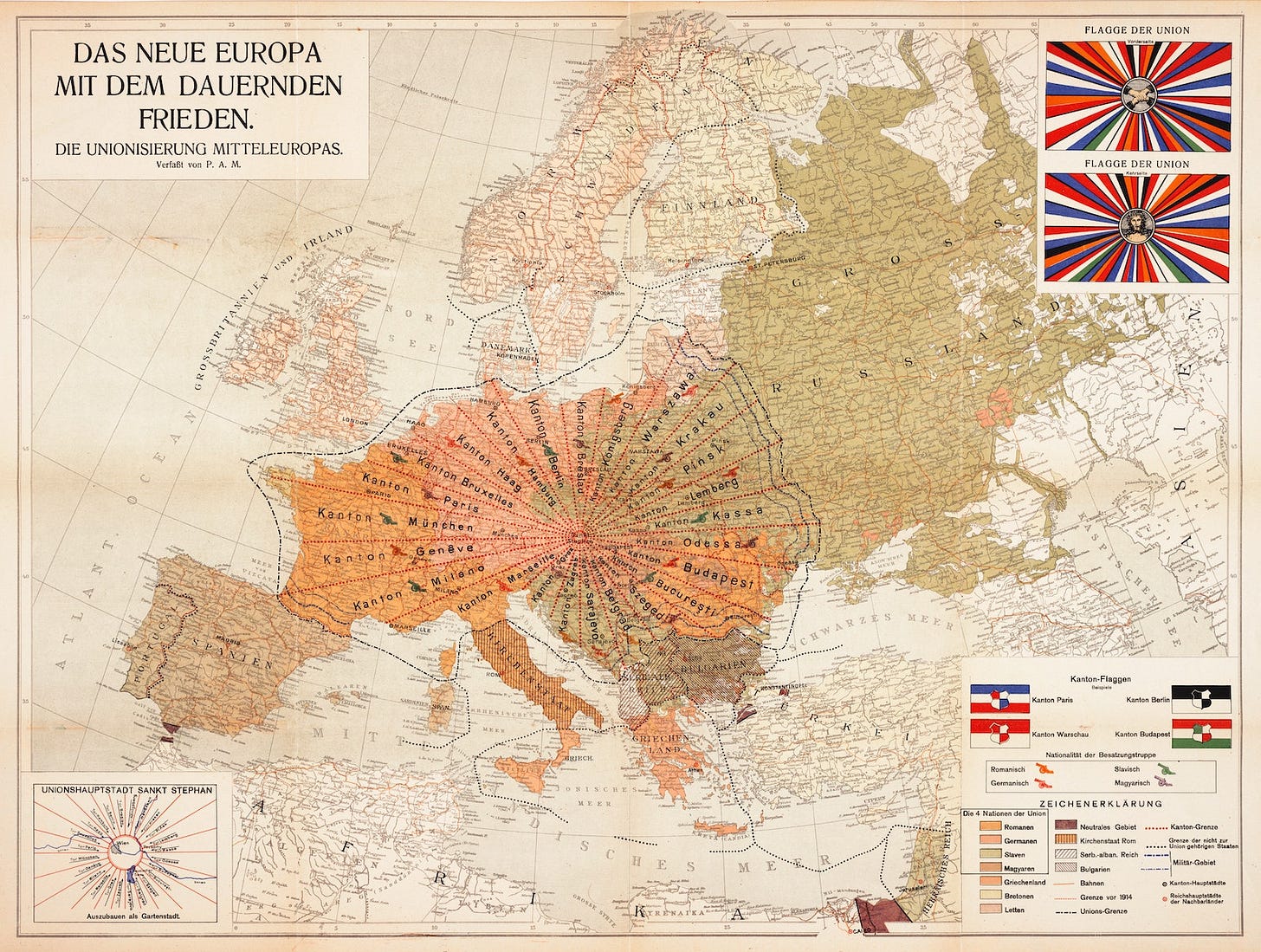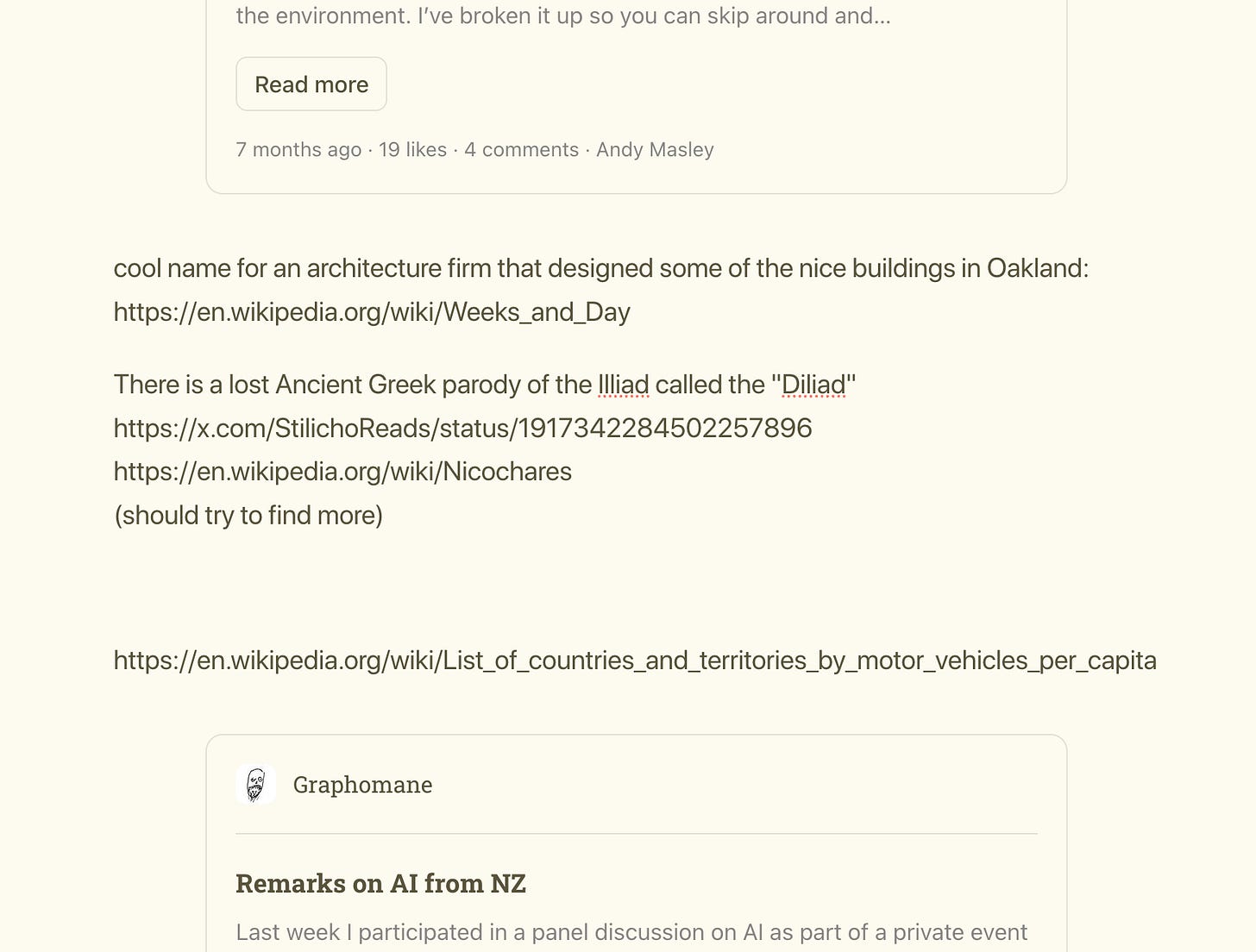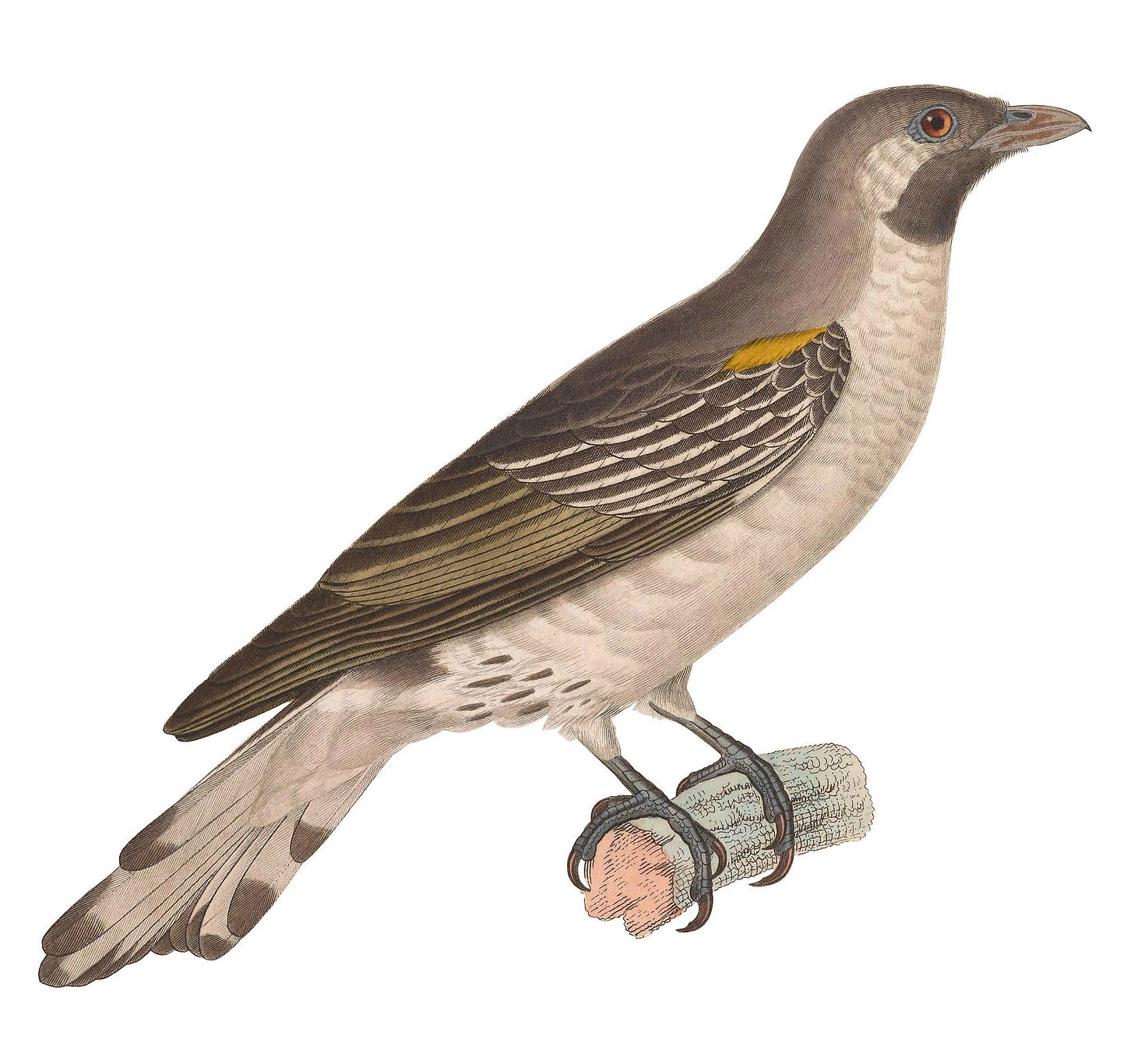Atlas of Links #3
May–November 2025

Previously: Atlas of Links #2
0.
A meta reflection: I feel I’m kinda bad at making these list posts. I read a lot of stuff, but only very occasionally do I remember to paste the link in here. When I do, it contributes to a growing messy list of raw links that initially looks like this:
It’s not representative of what I read, nor is it organized by theme or topic or time or anything. It’s not even clear why most of the links are supposed to be interesting, or what I was thinking when I put them there. I want the archiving of links to be low-effort, but then that means more effort when I decide to actually publish the post. That turns it into a chore, and so I put it off for months, and as a result I further forget what I had in mind, while the list gets longer. Irregularly, anyway.
Regardless, I’m publishing this post today, while having breakfast in Tokyo, for the usual reason that I publish a post: I found cool cover art. It’s a map of an insane proposal to divide much of Europe in order to prevent things like World War I. Via Public Domain Review’s Twitter account; more here. (Public Domain Review is truly one of the best websites in existence.)
I.
I’ve had this draft open so long that the first thing I put in at was some bragging about my short story in Protocolized, which was published back in May. Feels irrelevant 6 months later, but let’s share it again, why not!
II.
When I talked about the tech tree a lot, people would often comment that it would be a useful tool to rebuild our industrial civilization if we ever lost everything in a cataclysm. I am skeptical that we need something like this (since we rarely lose technology, and a civilization-wiping cataclysm is unlikely to happen and to let a resource like the tech tree survive), but I agree that as a thought experiment it’s pretty cool. And since it’s cool, a company called Hungry Minds has created a cool book around the concept, The Book: The Ultimate Guide to Rebuilding Civilization.
I’m not a huge fan of the art style, but the many diagrams it contains seem fun. I learned about the book from Zion Lights’s substack.
III.
Related to the point that technologies are rarely lost: are mineral resources ever lost? They’re not renewable, so you would expect that we eventually hit shortages of things like metals, stones with specific properties (like kinds of marble), etc. Apparently the answer is probably not. Most likely, this is for standard economic reasons: once a mineral becomes rarer, its price increases, and therefore we slow down and eventually stop exploiting what remains as we switch to alternatives.
IV.
Related to the tech tree, I love it when people use it as a starting point to write their own blog posts. Eli Stark-Elster started his substack earlier this year and it’s great. This post is about alien tech:
V.
By the way, if you ever want to make friends with a blogger, it’s very easy: just write a followup to one of their posts. If you’re minimally thoughtful about it, they’ll be super happy. Eli did this and asked me for feedback before publishing the above post. I did this with Linch Zhang at The Linchpin by viciously attacking (not actually viciously) his post on epistemology on the topic of cultural evolution. Then, recently, Linch cited my response as the top example of “The Greatest Compliment Someone Can Pay My Writing” and now it feels like I have two new friends (though I haven’t met them. Yet!).
VI.
A few years ago I wrote about the moon, and how it’s generally poorly represented in art and media. We tend to treat the moon as an abstract symbol of night, and therefore make it look or behave unlike the real moon. For example, you’ll never see a moon crescent rise at sunset (moon crescents rise only at 3 AM and 9 AM). I was reminded of my post when reading The Last Psychiatrist on How To Draw (This Is Not An Article About How To Draw): if you try to draw something without being careful, you’re likely to draw a symbolic representation of the thing rather than what the thing actually looks like. The post offers various remedies.
VII.
I often spend time in Oakland, California, and though I wouldn’t say it’s a pretty city, it has some really nice buildings. I’m especially fond of this one:
It was built by a firm with the cool name of Weeks and Day (named after the two cofounders and unrelated to the concept of time), which was especially active in the 1920s.
VIII.
There was apparently a (now lost) Ancient Greek parody of the Iliad called the “Diliad,” attributed to some guy named Nicochares. I’m really sad that this is lost and wish somebody wrote a plausible reconstruction of it. I’ll even take an AI-generated version, if it’s good.
IX.
Pop quiz: Which country has the most cars per capita? Hint #1: it’s in Europe. Hint #2: it’s a microstate, which I guess is cheating because anything can happen when you have both a per capita statistic and a very small population. The answer is San Marino. If we exclude microstates, the answer is apparently… Taiwan? The list is on Wikipedia.
X.
Neal Stephenson writes excellent science fiction novels, and more recently, a pretty good substack too. Come for the futurist’s thoughts about AI, stay for the analogy of humans to eyelash mites.
XI.
Cool economics paper answering various questions about notable paintings, including this chart by country, which seems like a decent proxy for relative cultural power over time:

XII.
Paraguay in the first half of the 19th century, under the Supreme and Perpetual Dictatorship of José Gaspar Rodríguez de Francia right after independence, was a surprisingly wild place! Francia:
wanted to create a society inspired by Rousseau, Napoleon, and Robespierre (yikes)
isolated the country and forbade all foreign trade
forbade European-descended Paraguayans to marry other European-descended Paraguayans, so that everyone would be mestizo or mulatto
abolished higher education (under the rationale that he had a private library if someone really needed to study something)
XIII.
When I visited the Tate Modern in London this summer, Babel was my favorite artwork.
XIV.
I finally got acquainted with Ayn Rand’s novels earlier this year, which means I have unlocked the power to see Randian villains everywhere. Randian villains are a bureaucrat who use state power to suppress productivity and dispose of other people’s talents in the name of the greater good. Recently, I saw them in this post from Anton Howes, about the “dystopian” work conditions of wage laborers in England from 1350 to 1750: “policies sometimes so absurdly and ambitiously oppressive that as I discovered more about them my jaw just kept on dropping.” For example, statutes introduced in the 14th century after the Black Death made it illegal to try to move between cities to search for better work, and wages and prices were centrally controlled by the government in order to tackle inflation — which obviously didn’t work, and let to even more bad regulation, for decades and centuries. All of that reeks of Directive 10-289 in Atlas Shrugged, but worse, not to mention that it actually happened.
XV.
In the last links post I discussed what I called the brutalist lab aesthetic. Since then I discovered the U.S. Graphics Company, run by Neil Panchal. A great example of the style, though I have found the guy to be a bit annoying on Twitter.
XVI.
The honeyguides are a family of birds that are known to, as their name suggests, guide people to honey. They do this so that they can eat the beeswax and larvae after the humans have harvested the honey. This really sounds fake, like someone came up with this idea as a concept for a new Pokémon, but it’s real, and may be an example of co-evolution. Also, the main genus in the family has a cool and fitting name: Indicator, and the scientific name of the best-known species, the greater honeyguide, drives the point home further: Indicator indicator. The indicator that indicates. Really sounds like an uninspired Pokémon name.
XVII.
People love sharing this chart to bemoan the loss of color in the modern world:
What people seem to never mention is that it comes from this article, a really cool account of how the Science Museum Group people in the UK collected the data, by analyzing the pixels in standardized photos of museum artifacts. This lack of source attribution often leads to commenters making fools of themselves by pointing out that color photography wasn’t around in the 19th century, which is totally irrelevant since all the photos are recent.
But also, it seems to have escaped everyone except myself that the apparent red/orange/yellow color domination from 1800 to ~1960 is mostly just that wooden objects were more prevalent then, as well as gold-colored metal, like brass. Though there was definitely a rise in black, gray, and white objects after the 1980s, that’s also when blue and green become more prevalent, which suggests that we do live in a more colorful world now than in the past, as one would expect from our greater wealth.

XVIII.
How common is multiple invention? Pretty common! Brian Potter discusses what multiple invention means, and then quantifies it. I’m glad I decided early on in the tech tree project to not worry about it and just record the first instance of everything. Not that this saved me from agonizing over many an ambiguous case.
XIX.
I agree with this take on space colonization: it seems likely that the people living in the harsh environment of Mars colonies or in space stations will crave coziness, and therefore their habitats won’t be the smooth, bland, minimalist aesthetic we see in a lot of science fiction. Instead, as soon as the colonies accumulate sufficient resources, they’ll tend to become comfy, baroque, and reminiscent of the Earth.
XX.
Cate Hall writes about quitting. A few years ago I quit a good job without a plan. This year I quit a long romantic relationship. In both cases my life greatly improved, though neither was easy in the moment. I wouldn’t say that “leave now” is necessarily good advice all the time, but yeah, it’s good to meditate on the benefits of quitting, if only to balance the (equally necessary, but overemphasized perhaps) benefits of commitment and determination.
XXI.
Stripe cofounder Patrick Collison visits the Faroe Islands, comes back impressed. An excerpt that hits close to home for me and my obsession about cultural diversity:
What does one learn from the Faroes? It feels clearly to the betterment of the world that they exist. Some of this is in the natural splendor, but some is also in seeing what a micro-nation is capable of. Are the Faroes an example of how clearly-defined polities are a bottleneck for the advancement of the world? To the extent that cultures establish the preconditions for anything, and to the extent that appreciation for and consumption of humanity’s creations are among the most durable sources of welfare, should we want more Faroes? Do the Faroes, with isolation enforced by maritime tyranny, hint at what is lost in global integration?


















Taiwan has very low car ownership per capita. The statistic cited is for motor vehicles, which makes sense because scooters are everywhere there.